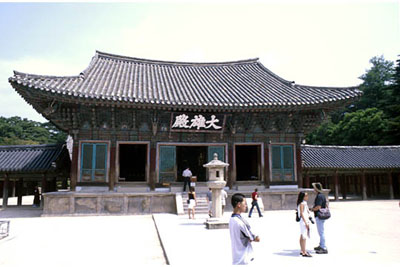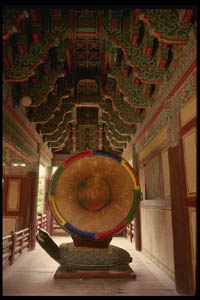|
Intro
History
Vernacular
Architecture
High-Style Architecture
Bibliography
Links |
|

In front of Taeung-Jon Hall
|
|
By
passing beyond the pagodas and into the hall, the worshipper
symbolically reaches
Nirvana. Each step is
representative of the journey the soul must take. As
can be seen, the main hall, Taeung-Jon Hall, was built using the
Tap'o style (Note the brackets that are situated between the
columns). This style was popular with Buddhists as a symbolic
representation of the complexity of the cosmos. This
particular hall measures 53 feet by 47 feet.
|
|
Surrounding
the temple complex are richly decorated arcades punctuated at the
corners with pavilions. These are known as the Haengnaeng
Corridors. The arcade that divides the temple is punctuated at
the outer wall with a similar pavilion, but this particular one
holds a drum.
The Haengnaeng corridors terminate just beyond Taeung-Jon
at Musol-Jon Hall, the largest of the buildings on the site.
This meditation hall is 112 feet long. According to a record
from King Mun-mu's time, this building originally had thirty-two
rooms. If so, this marks the site of an earlier temple.
|

Drum hall photograph courtesy of
University of Idaho Media Desk
|
The Pul-guk-sa
Temple complex is very large. Beyond the Haengnaeng
Corridors and Musol-Jon Hall are several Tap'o shrines dedicated to
Buddha that are situated on different tiers.
|
|
In
addition to Pul-guk-sa Temple, it should be noted that there is
another extremely important shrine nearby:
Sokkuram Grotto, a man-made shrine in Mt. Tohamsen.
Sokkuram Grotto also owes its existence to Kim Tae-Song, who
finished the rock-hewn grotto sometime after finishing with
Pul-guk-sa Temple. There is some confusion over why the grotto
was actually built: according to some sources, it was a
memorial to Kim Tae-Sung's parents. However, it's proximity to
King Munmu's tomb leads some scholars to believe that it was built
as a spiritual protection from the Japanese: King Munmu was
cremated and cast into the sea to become a sea dragon that would
protect the kingdom from the east. As the grotto's entrance is
situated to look east out over the East Sea, it is possible that the
Silla Kings built Sokkuram so that the Buddha would offer protection
from invasion.
While
it is similar to carved-caves in both India and China, this Silla-era
cave-temple is utterly unique in Korea. There were earlier
rock-hewn caves in Korea, but they were much cruder.
|

 
|



|